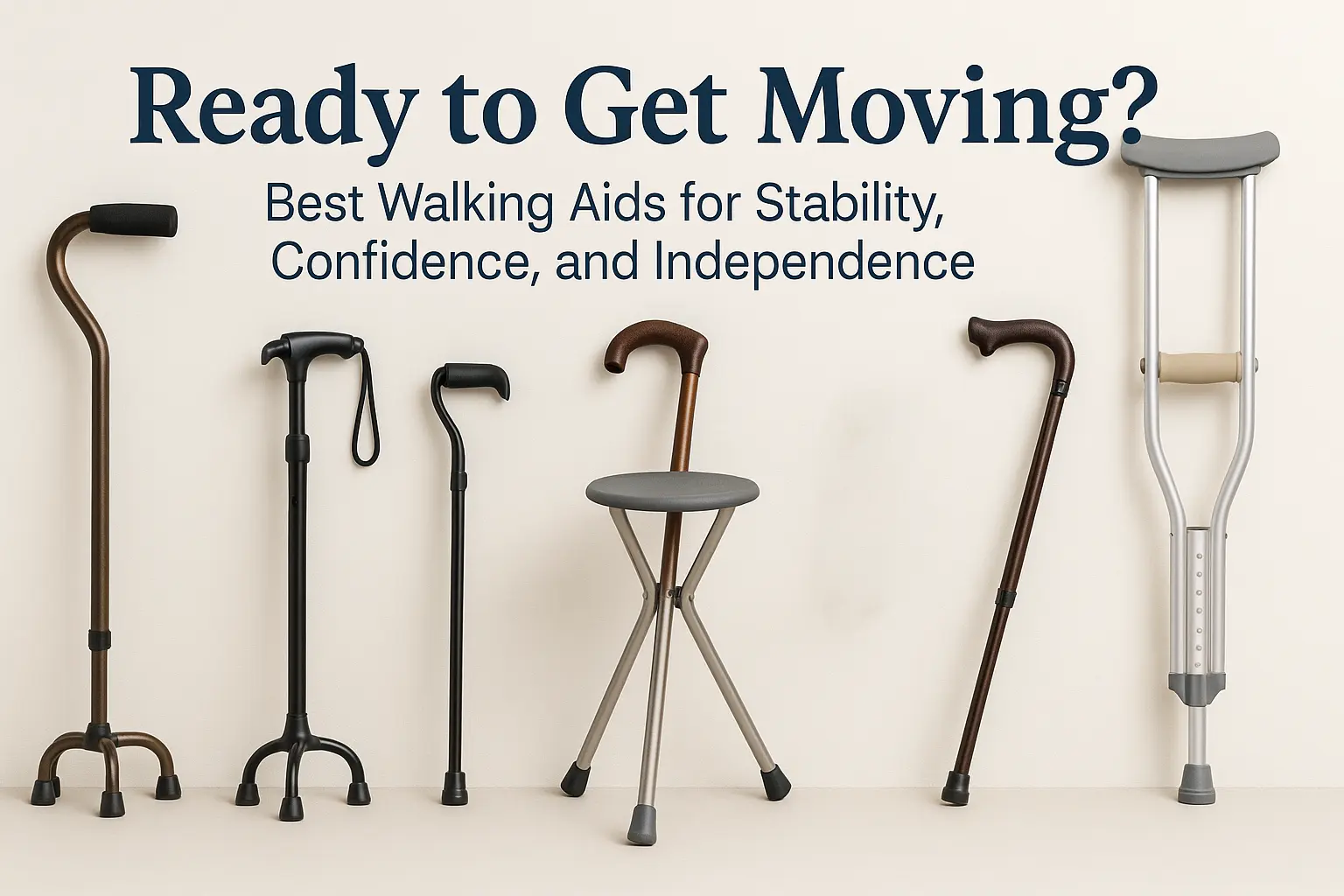A walking cane provides independence, support, and balance and is a tool for mobility. The correct cane can physically and symbolically be a beacon of support when recovering from an injury or navigating the aftermath of an accident. Walking canes play a crucial role in enhancing mobility and independence for seniors. As individuals age, they may experience challenges with balance and stability, making it difficult to move around safely.
Introduction
Seniors’ mobility, stability, and general quality of life can all be greatly impacted by their choice of walking cane, making it an important choice. A walking cane is necessary for independence and daily tasks because ageing can cause balance, strength, and coordination changes. Many options are available when choosing a walking cane, so evaluating several aspects carefully is important. These elements include different materials, designs, and features. We’ll go over key factors in this guide to assist seniors and those who care for them in selecting the ideal walking cane to suit their needs and tastes.

Choosing Walking Canes for Seniors
Several crucial elements must be considered to ensure that your walking cane offers the best support, comfort, and functionality. An extensive summary of the elements to take into account before picking a walking cane is provided below:
- Height and Weight Capacity: The user’s height is important when choosing a walking cane. The cane’s height should be easily adjusted to fit the user for the best alignment and support. It’s also critical to consider the cane’s weight capacity to sustain the user’s weight without sacrificing stability or longevity.
- Handle Grip and Material: The handle grip of the walking cane plays a crucial role in user comfort and safety. Look for a comfortable and ergonomic handle grip, preferably made from non-slip material such as rubber or foam. The grip should provide a secure hold and minimize hand fatigue, especially during extended use.
- Comparison of Single-Point and Quad Bases: Determine the most appropriate for your walking style and stability requirements. Quad canes provide more stability and support, especially for people with balance problems or mobility constraints. Single-point canes are appropriate for people who need less support and stability.
- Folding vs. Non-Folding: Consider whether portability is your priority when choosing a walking cane. Folding canes are designed for convenience and portability, allowing users to collapse and store the cane when unused. On the other hand, non-folding canes may offer additional stability and durability but could be more convenient for travel or storage.
- Evaluating Mobility Needs: It’s vital to determine your stability needs and mobility restrictions before investing in a walking cane. Inspect the degree of your mobility restrictions and ascertain the required level of stability based on your ability to balance and coordinate.
- Seeking Professional Advice: Physical therapists and healthcare consultants can offer insightful advice on which walking cane suits your unique requirements. They can evaluate your mobility problems and suggest the best solutions based on your unique situation.
- Testing and Adjusting: Once you’ve identified a potential walking cane, testing and making necessary adjustments is essential to ensure proper fit and functionality. Adjust the cane to the appropriate height and try it on various surfaces to provide stability and comfort.
- Quality and Durability: Choose a walking cane from high-quality materials and durable construction to ensure longevity and reliability. Check for warranties and read customer reviews to gauge the quality and reliability of the chosen walking cane.
- Personalization and Comfort: Select a walking cane with customizable features and ergonomic designs to maximize comfort and usability. Look for canes with adjustable height, interchangeable grips, and optional accessories to tailor the cane to your preferences.
- Cost and Affordability: Consider your budgetary constraints when selecting a walking cane and weigh the value against the price. Explore affordable options without compromising on quality or essential features, ensuring you get the best value for your investment.
Different Types of Waking Cane
It’s important to take into consideration the different kinds of walking canes that are available to suit individual needs and tastes before making your choice:

Standard Walking Canes
Through a single-point base, standard walking canes are the most popular kind. These are good for people who only need a little solidity or assistance. Seniors who occasionally struggle with mobility or have mild balance concerns often utilize them. Standard walking canes are available in various styles and materials, so users can select one that best suits their tastes and personal style.
Adjustable Canes
Canes with height-adjustable shafts enable users to tailor the cane to meet their unique height needs. These canes provide individualized support and are appropriate for users of different heights. Telescopic shafts on adjustable canes can be extended or retracted to adjust the height. With this feature, you can be sure that the cane is made ergonomically to encourage good posture and comfortable use. Because of their adaptability and versatility, adjustable canes are a good option for users needing regular adjustments or suffering mobility changes.
Quad Canes
Compared to regular canes, quad canes have a four-point base, offering more stability and support. Because the quad base design evenly distributes the user’s weight across a larger area, it is perfect for anyone who struggles with balance or limited movement. Quad canes are useful for people who want additional assistance when crossing obstacles or rough surfaces. They’re a popular option for elders and people healing from injuries since they provide more stability and lower the chance of falling.
Folding Canes
Folding canes have been designed to be portable and convenient. Because of this functionality, folding canes are perfect for people who need a cane for occasional use or travel regularly. People can take folding canes anywhere because they are portable and usually include a carrying case or strap.
Aesthetics and Personal Style
Many options are available for seniors who want walking canes in style and functionality. Consider these factors:
- Walking canes are available in various materials, including wood, metal, and carbon fibre. As for the design of the cane, it can be carved or painted, sleek metal, or decorated.
- There are many colours and patterns of walking canes, from classic solid colours to bold prints and patterns. Colours and designs can be selected based on the senior’s style or wardrobe.
- Customization Options – Some walking cane manufacturers offer customization options like engraving or monogramming. Seniors who want to make their canes unique can consider this an excellent choice.
- As important as aesthetics are, choosing a comfortable and ergonomic cane is equally important. Ensure the cane provides adequate support and comfort by considering factors such as the type of grip and handle design.
- Accessories such as wrist straps and carrying cases are available for some walking canes for seniors. They’re useful for seniors who want to keep their cane nearby or need it easily accessible.

Safety Precautions and Proper Usage
Safety precautions and proper usage are crucial when using walking canes effectively and minimizing the risk of accidents or injuries. Here are some important safety tips to keep in mind:
Using the Cane on Stable Surfaces
When using a walking cane, it’s essential to ensure that you walk on stable surfaces to prevent slips and falls. Choose well-maintained pathways and avoid areas with loose gravel or debris. Using the cane on stable surfaces enhances stability and reduces the risk of accidents, promoting safe and confident mobility.
Proper Posture and Gait
Maintain good posture while using the walking cane to ensure proper weight distribution and balance. Stand upright with your shoulders relaxed and your head held high. Hold the cane in the hand opposite to the side of the body that needs support. Take slow, deliberate steps, keeping your feet shoulder-width apart and your knees slightly bent. Avoid leaning heavily on the cane, which can strain your muscles and joints.
Avoiding Slippery or Uneven Terrain
Be cautious when navigating challenging or unfamiliar surfaces, such as stairs, ramps, or curbs. Take your time and use handrails or other support structures whenever possible. Avoid icy or wet surfaces, as these can be particularly hazardous. If you encounter obstacles or hazards, such as uneven pavement or potholes, proceed with caution and consider seeking an alternative route.
Inspection of the Cane
Periodically inspect the walking cane for any signs of damage or wear and tear. Check the rubber tips or ferrules for signs of wear, such as cracks or smoothness, and replace them to maintain traction and stability. Ensure the height adjustment mechanisms function correctly and the cane is securely locked. Clean the cane regularly to remove dirt, debris, or moisture that could affect its performance.
These safety precautions and practising proper cane usage can minimize the risk of accidents and injuries while maximizing the benefits of using a walking cane. Remember always to prioritize safety and take proactive measures to maintain the condition of your cane for optimal performance and reliability.
Final Thoughts
The purpose of a walking cane is to provide support and stability so that seniors can move about independently. Canes come in a variety of styles and designs to fit different needs. Choosing the right walking cane for seniors requires considering their physical build and mobility needs. Consider the cane’s weight, height, and ergonomic features to ensure safety and comfort. Seniors can also choose one that reflects their style and personality.
FAQs: Walking Cane
What is the best cane for seniors?
The best cane for seniors depends on individual needs and preferences. Standard canes offer basic support, while quad canes provide greater stability. Adjustable canes accommodate varying heights, and folding canes offer convenience. Consult with healthcare professionals to determine the most suitable option.
Which cane is best for balance?
Quad canes are often considered the best option for seniors seeking improved balance. With their four-point base, quad canes provide greater stability and support, making them ideal for individuals with balance issues or mobility limitations.
When should a senior use a cane?
Seniors should consider using a cane if they experience difficulties with balance, mobility, or stability while walking. Common indicators may include unsteadiness, a fear of falling, or joint pain. Consulting with a healthcare provider can help determine if a cane is appropriate and beneficial for individual needs.
Which is better, a cane or a walker?
Choosing between a cane and a walker depends on seniors’ mobility needs and abilities. Canes are more lightweight and provide less support but offer greater manoeuvrability. Walkers offer more stability and support but may be bulkier and less agile. Healthcare professionals can help determine the most suitable option based on individual circumstances.






